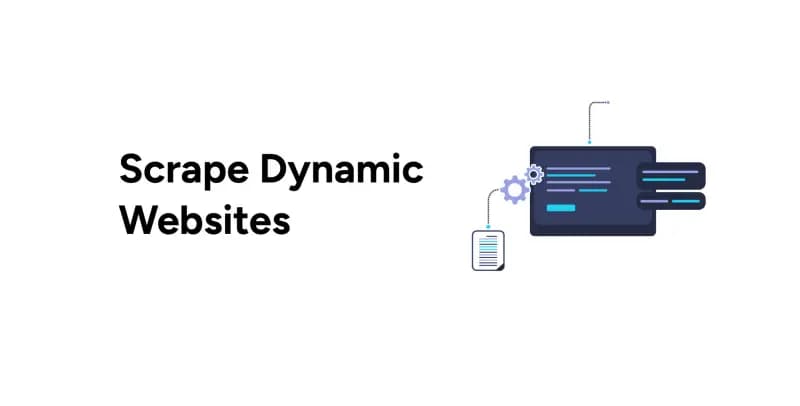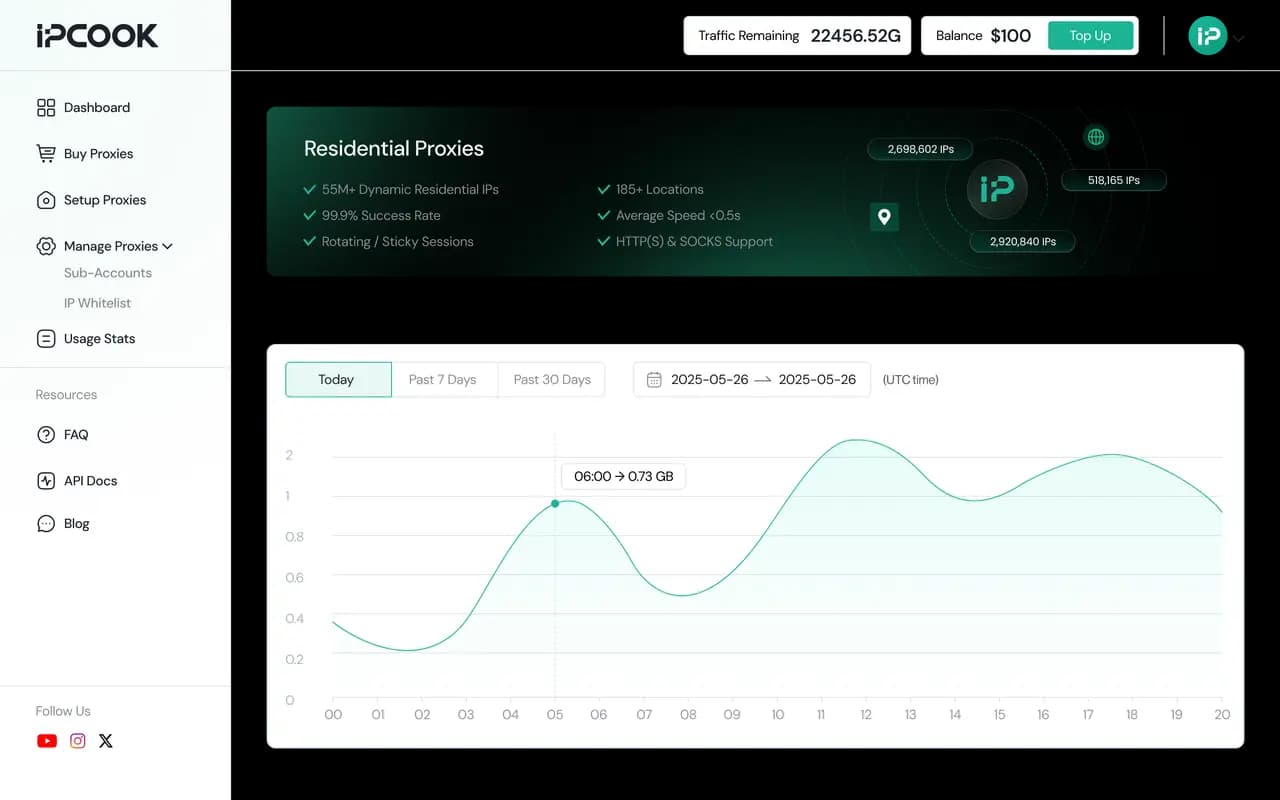Web Page Dynamic Content: What Is It and How to Scrape It

Have you ever tried extracting product prices, stock updates, or personalized recommendations from a website, only to find the data missing in the page source? That's because you're dealing with web page dynamic content: information that loads in real time via JavaScript, often invisible to traditional scrapers.
In this article, we'll break down what dynamic content really is, why web scraping dynamic content can be so tricky, and how you can reliably collect this data using Python and IPcook residential proxies. Whether you're a beginner or an automation expert, you'll find practical solutions that match your needs.
What Is Dynamic Content on a Website? How Does It Work?
Dynamic web content refers to webpage elements that are generated and displayed based on real-time data, user behavior, location, or device settings. Unlike static content, which is hard-coded in HTML and appears the same to every visitor, dynamic content websites deliver personalized experiences tailored to each user.
Common Examples of Dynamic Webpages
- Personalized recommendations: E-commerce stores display different product suggestions based on your browsing or purchase history.
- Real-time updates: News portals show live headlines, stock prices, or weather forecasts that refresh without reloading the page.
- User-specific content: Logged-in users see customized dashboards, localized languages, or membership-specific information.
- Dynamic pricing: Prices change depending on region, demand, or time-of-day, and are day—frequently used in travel and ride-hailing apps.
In contrast, static websites serve fixed content. A typical blog post or company info page contains HTML that rarely changes and can be scraped easily using basic tools. However, most modern websites rely on dynamic elements to stay relevant and interactive.
How Dynamic Content Works
When you load a dynamic webpage, your browser receives an initial HTML skeleton. The actual content, like tables, charts, or listings, is loaded asynchronously through JavaScript after the rendered page. This data usually comes from APIs, databases, or CDNs.
Common technologies used to inject this content include:
- AJAX (Asynchronous JavaScript and XML)
- Fetch API
- WebSockets
As a result, scraping dynamic websites becomes tricky. If you only retrieve the page's raw HTML, the essential data might be missing altogether. This leads to a critical challenge: Traditional scraping tools can't access data that only appears after JavaScript execution.
Why Is Scraping Dynamic Web Pages So Challenging?
Web scraping dynamic content isn't as straightforward as extracting static HTML. Dynamic pages are designed for interactivity and personalization, which makes them harder for bots to access. Here are the main challenges:
The Data Isn't in the Initial HTML
When you inspect a dynamic webpage's source code, you might find nothing useful. That's because the key information (like product lists, prices, or reviews) is injected after the page loads. Traditional scrapers that rely on HTML parsing simply miss this content.
JavaScript Rendering Is Required
Dynamic content relies on JavaScript to fetch and display information. This means the actual content only becomes visible after JS is fully executed, often a few seconds after the initial page load. To access it, your scraper must simulate a browser environment, which adds complexity and slows down extraction.
Complex Loading Mechanisms
Many dynamic websites use:
- Infinite scrolling
- Lazy loading
- Paginated AJAX calls
These patterns require your scraper to detect, scroll, and wait for elements to appear—steps that don't exist on static pages.
Anti-Scraping Protections
Dynamic pages often include robust anti-bot systems:
- IP rate limiting or geo-restrictions
- JavaScript challenges or fingerprinting
- CAPTCHAs and token-based authentication
- Session management with expiry or redirect traps
In short, dynamic pages aren't just harder to scrape, as they're built to actively resist. So, how can you still extract the data you need? Let's walk through effective methods to scrape data from dynamic websites.
Method 1. Use Python to Scrape Dynamic Content (with Code Example)
When it comes to web page scraping, Python remains one of the most powerful and flexible tools available. Its rich ecosystem of libraries makes it ideal for handling everything from simple HTML parsing to complex JavaScript-rendered websites.
Static vs. Dynamic Scraping in Python
- For static pages, tools like "requests" and "BeautifulSoup" are often enough.
- But for dynamic websites, where content loads after JavaScript execution, you'll need browser automation tools like Playwright or Selenium.
These libraries simulate a real browser session, allowing you to wait for the content to load, interact with the page, and extract what you need.
Python Code Example: Scrape Dynamic Table to Excel
Here's a simplified Python example using Playwright to scrape a table from a dynamic webpage and export it to Excel. With full control over what and when to scrape a website automatically, and the flexibility to handle interactive elements like scrolling and clicks, this method offers a highly customizable approach to extracting data from complex pages.
from playwright.sync_api import sync_playwright
import pandas as pd
with sync_playwright() as p:
browser = p.chromium.launch(headless=True)
page = browser.new_page()
page.goto("https://example.com/dynamic-table")
page.wait_for_selector("table")
data = page.locator("table").all_inner_texts()
df = pd.DataFrame(data)
df.to_excel("output.xlsx", index=False)However, scraping dynamic content can be resource-intensive and slow. Repeated requests may lead to your IP being blocked, and handling high-traffic or multi-page sites demands serious scalability. To overcome these challenges and enable large-scale, reliable scraping, you'll need more than just a script, and that's where residential proxies like IPcook come in.
Method 2. Combine Automation with IPcook Residential Proxies 🔥

Modern websites are getting smarter at detecting bots. If your scraping script sends too many requests, accesses restricted regions, or fails behavioral checks, chances are you'll get blocked. From IP bans and CAPTCHAs to rate-limiting and token-based authentication, these anti-scraping defenses are designed to stop you.
So, how do professional scrapers get around this? The answer is to combine automation tools with residential proxy scraping. By routing your traffic through real household IPs, you can avoid detection and access dynamic content like a regular user. You can experience the best web data scraping services.
Why IPcook Is Best for Web Scraping Dynamic Content
When it comes to scalable, stealthy scraping, IPcook offers a robust set of features:
- Dynamic Residential IPv4 Proxies with high anonymity and stability;
- Automatic IP Rotation to bypass rate limits and geo-blocking;
- Massive Clean IP Pool, ideal for high-frequency and multi-site scraping;
- Supports HTTPS and SOCKS5, fully compatible with Python, Playwright, and Selenium;
- Simple Integration and pay-as-you-go pricing—perfect for both beginners and teams.
Sample Setup: Playwright + IPcook + Excel Export
Here's how you can configure IPcook in your Playwright scraping workflow.
- Get an IPcook plan and note your proxy IP and port.
Set up the proxy in your script.

- Launch a browser and wait for the dynamic content to load.
- Extract data from the rendered page and export it to Excel.
This setup ensures your scraper behaves like a real user and minimizes the chance of being blocked. If you want to scale your scraping projects reliably, just try IPcook residential proxies today and turn dynamic data into Excel with confidence!
Conclusion
In this article, we explored 2 effective methods for scraping dynamic web content: using Python automation tools like Playwright for flexible, customizable scraping and combining automation with IPcook's high-quality residential proxies to overcome anti-scraping barriers.
Choosing the right approach depends on the complexity of your target website and how frequently you need to collect data. For high-frequency, stable scraping with a higher success rate, IPcook's dynamic residential proxies offer a reliable solution. Whether you're a beginner or an experienced developer, this guide provides a suitable method to help you scrape dynamic webpages efficiently.
